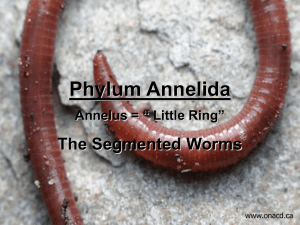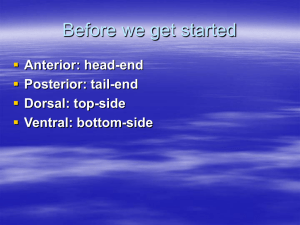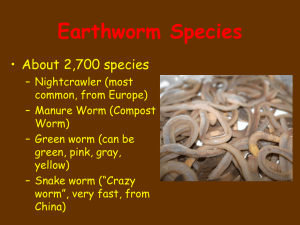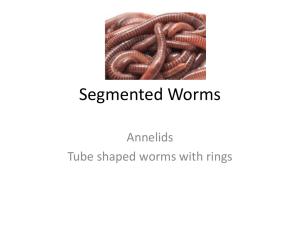Earthworms in Soil Restoration: Lessons Learned Reclamation Kevin R. Butt
advertisement
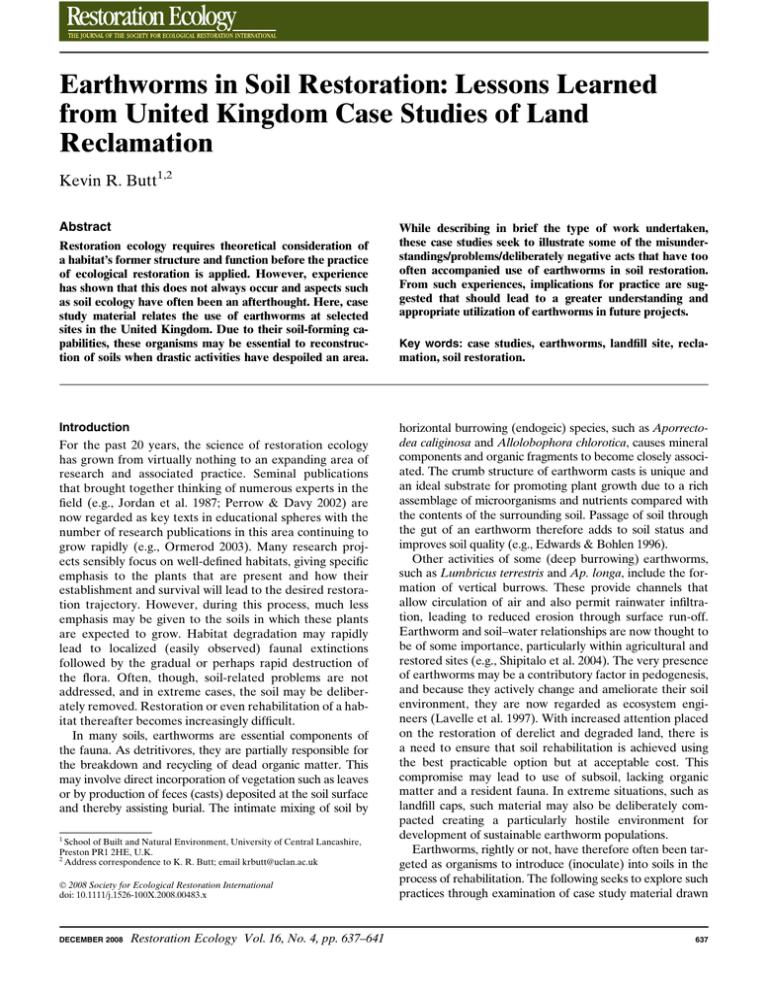
Earthworms in Soil Restoration: Lessons Learned from United Kingdom Case Studies of Land Reclamation Kevin R. Butt1,2 Abstract Restoration ecology requires theoretical consideration of a habitat’s former structure and function before the practice of ecological restoration is applied. However, experience has shown that this does not always occur and aspects such as soil ecology have often been an afterthought. Here, case study material relates the use of earthworms at selected sites in the United Kingdom. Due to their soil-forming capabilities, these organisms may be essential to reconstruction of soils when drastic activities have despoiled an area. Introduction For the past 20 years, the science of restoration ecology has grown from virtually nothing to an expanding area of research and associated practice. Seminal publications that brought together thinking of numerous experts in the field (e.g., Jordan et al. 1987; Perrow & Davy 2002) are now regarded as key texts in educational spheres with the number of research publications in this area continuing to grow rapidly (e.g., Ormerod 2003). Many research projects sensibly focus on well-defined habitats, giving specific emphasis to the plants that are present and how their establishment and survival will lead to the desired restoration trajectory. However, during this process, much less emphasis may be given to the soils in which these plants are expected to grow. Habitat degradation may rapidly lead to localized (easily observed) faunal extinctions followed by the gradual or perhaps rapid destruction of the flora. Often, though, soil-related problems are not addressed, and in extreme cases, the soil may be deliberately removed. Restoration or even rehabilitation of a habitat thereafter becomes increasingly difficult. In many soils, earthworms are essential components of the fauna. As detritivores, they are partially responsible for the breakdown and recycling of dead organic matter. This may involve direct incorporation of vegetation such as leaves or by production of feces (casts) deposited at the soil surface and thereby assisting burial. The intimate mixing of soil by 1 School of Built and Natural Environment, University of Central Lancashire, Preston PR1 2HE, U.K. 2 Address correspondence to K. R. Butt; email krbutt@uclan.ac.uk Ó 2008 Society for Ecological Restoration International doi: 10.1111/j.1526-100X.2008.00483.x DECEMBER 2008 Restoration Ecology Vol. 16, No. 4, pp. 637–641 While describing in brief the type of work undertaken, these case studies seek to illustrate some of the misunderstandings/problems/deliberately negative acts that have too often accompanied use of earthworms in soil restoration. From such experiences, implications for practice are suggested that should lead to a greater understanding and appropriate utilization of earthworms in future projects. Key words: case studies, earthworms, landfill site, reclamation, soil restoration. horizontal burrowing (endogeic) species, such as Aporrectodea caliginosa and Allolobophora chlorotica, causes mineral components and organic fragments to become closely associated. The crumb structure of earthworm casts is unique and an ideal substrate for promoting plant growth due to a rich assemblage of microorganisms and nutrients compared with the contents of the surrounding soil. Passage of soil through the gut of an earthworm therefore adds to soil status and improves soil quality (e.g., Edwards & Bohlen 1996). Other activities of some (deep burrowing) earthworms, such as Lumbricus terrestris and Ap. longa, include the formation of vertical burrows. These provide channels that allow circulation of air and also permit rainwater infiltration, leading to reduced erosion through surface run-off. Earthworm and soil–water relationships are now thought to be of some importance, particularly within agricultural and restored sites (e.g., Shipitalo et al. 2004). The very presence of earthworms may be a contributory factor in pedogenesis, and because they actively change and ameliorate their soil environment, they are now regarded as ecosystem engineers (Lavelle et al. 1997). With increased attention placed on the restoration of derelict and degraded land, there is a need to ensure that soil rehabilitation is achieved using the best practicable option but at acceptable cost. This compromise may lead to use of subsoil, lacking organic matter and a resident fauna. In extreme situations, such as landfill caps, such material may also be deliberately compacted creating a particularly hostile environment for development of sustainable earthworm populations. Earthworms, rightly or not, have therefore often been targeted as organisms to introduce (inoculate) into soils in the process of rehabilitation. The following seeks to explore such practices through examination of case study material drawn 637 638 Ach, Ar, Dr, Ea, Ev (turf transfer) As above As above Lt (EIU) Steelworks; created soil Restoration Ecology Ac, Aporrectodea caliginosa; Ar, Ap. rosea; Ach, Allolobophora chlorotica; Al, Ap. longa; Dr, Dendrodrilus rubidus; Ea, Eisenia andrei; Ev, E. veneta; Oc, Octolasion cyaneum; Lr, Lumbricus rubellus; Lt, L. terrestris using the nomenclature of Sims and Gerard (1999). Substrate; species; timing; monitoring; integration Substrate; species; techniques Trial of method; laboratory comparisons None recorded Ev, Lr, Lt (‘‘dug in’’) Regraded landfill; created soil Stockley Park—1992 (Hallows 1993; Butt 1999) Hallside—1996/1997 (Craven 1995; Bain et al. 1999) (Butt 1999) Ach, Ac, Al, Lt, Oc (EIU) Capped landfill; compacted subsoil Commercial goals; biofuel production Limited survival Soil very poor; organic matter lacking; damage to site Timing; species; numbers Earthworm survival; organic matter incorporation Survival and spread; species critical; positive effect trees Ac, Al, Lt (broadcast) Capped landfill; created soil Hillingdon—1984 (Marfleet 1985; Butt et al. 1993) Calvert—1991/1992/ 2003 (Butt et al. 1997, 2004) Test method; confirm effects of earthworms Test method/species; record dispersal; experiments with trees Commercial goals; golf course Positive Outcomes Objectives Earthworm Species (Technique Used) Site Description; Soil Origin Location—Inoculation Date(s) (References) Choice of Earthworm Species, Number, Technique, and Timing The relative merits of major earthworm inoculation techniques are provided in Table 1. Examples of each have Table 1. Characteristics of selected case study sites of earthworm inoculation. Locations and Initial Soil Conditions Case study sites are linked through poor initial site conditions but no more than might be anticipated on reclaimed industrial sites. No major toxins were present within the sites, but all were deficient in good quality soils. Hillingdon had a subsoil topped with sewage sludge to provide adequate physical conditions for earthworms, whereas Hallside has sewage sludge plowed into the raw, shale-rich colliery spoil substrate. The sewage sludge content may initially have been conducive to epigeic earthworms but contained little mineral soil for geophagous, endogeic species such as Allolobophora chlorotica or deep-burrowing anecic animals such as Lumbricus terrestris. Due to the level of compaction (1.6–2 g/cm3) above an active landfill, high clay content, and no addition of organic matter, the subsoil medium at Calvert was not ideal for earthworm inoculation. However, of great value was the initial support from site managers to assist experiments of this nature plus a reclaimed soil (in extremis) to trial a novel technique (earthworm inoculation unit [EIU]). By comparison, the regraded, passive landfill at Stockley Park was much more conducive to earthworms because a grass covering was established for amenity sport (golf) over a thin layer of stony soil. All the sites had certain deficiencies/problems but with appropriate management could have supported selected earthworms. Nevertheless, the species selected for use were not always ideal for the given soil conditions. Problems from four locations in the United Kingdom. These sites, at Hillingdon (Marfleet 1985; Butt et al. 1993), Calvert (Butt et al. 1997, 2004), Stockley Park (Hallows 1993; Butt 1999), and Hallside (Craven 1995; Bain et al. 1999), have been the focus of seven earthworm inoculation trials. Specific aspects drawn from these case studies (Table 1) where a variety of inoculation techniques were used (Table 2) cannot fail to demonstrate some of their achievements and successes, which are already documented in the literature and reviewed by Butt (1999). However, a specific aim here is to critically assess each of the operations by reference to problems, mistakes, or deliberate acts that failed to assist the specifically stated or inferred objectives. Thereafter, implications for practice in reclamation schemes are examined. The case studies chosen all relate to sites in Britain, simply because the author had a direct input into their establishment or was involved indirectly (usually through monitoring) at a later stage. Nevertheless, results have a wider bearing, and the positive aspects demonstrated can be transferred and the potential problems avoided in similar reinstated soils across temperate systems worldwide. Monitoring; methane Earthworms in Soil Restoration DECEMBER 2008 Earthworms in Soil Restoration Table 2. Relative merits of earthworm inoculation techniques (adapted from Butt et al. 1997). Technique Advantages Disadvantages Broadcast after chemical/ physical extraction High densities possible; species selection possible Turf transfer Protective microenvironment; cocoons transferred EIU Protective microenvironment; cocoons and all life stages present; high densities possible; control over numbers; species selection/combinations possible; no collection site to be damaged been used in the case studies presented (Table 2) plus a variant at Stockley Park, where broadcast inoculation was supplemented by earthworms being ‘‘dug in’’ to slots created in the turf of the receptor site. This cannot be regarded as a standard practice or one that will assist earthworm survival. Here, as on a golf course, the slots were closed (trodden down) after earthworm insertion— potentially leading to immediate mortality. Timing of this particular operation (over winter months) may have necessitated this practice to avoid deposited animals freezing on the soil surface. Use of broadcast inoculation at Hillingdon in 1984 was then seen as best practice, but the method of collection was a potential problem from the outset. This was because mass spraying of soil with formalin will have harmed the 4,000 collected animals if not washed immediately. Likely species used, determined by resampling the donor field, were Aporrectodea caliginosa, Ap. longa, and Lumbricus terrestris. All may not have been ideal candidates for the site due to the high organic matter content. Litterdwelling and other shallow-working species such as Red worm (L. rubellus) and Allolobophora chlorotica, respectively, would have been more suitable (but less easily collected). By contrast, the species used at Stockley Park were obtained commercially. They did not therefore suffer from any chemical exposure prior to use, but once again, the majority (commercially bred epigeic Eisenia veneta) of the 1.5 million inoculated (Hallows 1993) were not a suitable choice. This was confirmed during monitoring in later years, when none of this species was located (Butt 1999). Three trials saw development of the EIU technique (e.g., Butt et al. 1997). This mass rearing in plastic bags (Lee 1995) meant that species selection was possible, so appropriate species could be used as starter cultures. However, this in itself was part of the development process and species selection shifted in favor of Ap. longa and Al. chlorotica or a combination of both species over L. terrestris. The latter was a poor candidate species for DECEMBER 2008 Restoration Ecology Protective microenvironment absent; no cocoon transfer; mainly deep-burrowing (anecic) worms; worms may be injured during extraction; laborious and expensive; damage to collection site Densities usually low; little control over species/numbers; mainly surfacedwelling (epigeic and endogeic) worms; cutting machines/labor required; damage to collection site Laborious and expensive this site because it was less able to burrow into compacted clays than, e.g., Ap. longa (Kretzschmar 1991). However, site managers were initially keen to use L. terrestris contrary to the judgment of the scientists involved. During development and trialing of this technique at Calvert, the size of the unit was reduced (2 rather than 4 L) for ease of handling and inoculation into site. To prevent hatchling escape, sealed units were used during the 3-month cultivation phase. Netting was also pegged immediately above each EIU site following inoculation because site workers after the first trial reported that birds (corvids and gulls) from the nearby active landfill area had shown significant interest in the EIUs and likely reduced earthworm numbers through predation. In addition to monitoring the earthworms, their interaction with trees was also investigated in collaboration with the Forestry Commission. Over a period of a decade, Alder (Alnus glutinosa) had a significant positive effect on overall earthworm density, likely due to nitrogen additions. However, the earthworm treatments had no significant effect on tree growth, most likely as a result of extremely hostile soil conditions with low organic matter content and high compaction (Butt et al. 2004). The third trial at Calvert (March 2003) used Ap. caliginosa, Ap. longa, and Octolasion cyaneum from stock sources (e.g., Lowe & Butt 2005). This compared inoculation of earthworms into two adjacent 400-m2 plots, one of which had 40 tonnes of composted green waste (CGW) added as a surface dressing. At most recent sampling (3 years), the inoculated earthworm species were all recorded from the CGW plot, but only very low numbers of Ap. longa were found in the control plot. Site managers at Hallside (Scottish Greenbelt Company [SGC]) considered that provision of earthworms through use of the EIU technique might be of value to assist willow (Salix sp.) and poplar (Populus sp.) short rotation coppice production (Craven 1995). SGC therefore commissioned 2,000 (3 L) EIUs following the design of Butt et al. (1997) but with a substrate similar to that spread on 639 Earthworms in Soil Restoration site (colliery spoil and sewage sludge). The earthworm starter culture comprised 8,000 L. terrestris (obtained from a commercial supplier), and EIUs were inoculated into site by a commercial labor force. However, as at Calvert, this species was not suitable to the given soil conditions, and none were recorded during monitoring for the following 2 years (Bain et al. 1999). Recurring Problems/Specifics At Hillingdon, the site itself was not stable, and signs in 1990 revealed methane seepage that had reduced earthworm numbers to zero in places, such that no organic matter incorporation had occurred. However, monitoring of this site was not continuous, so it was difficult to draw firm conclusions. An inappropriate choice of earthworm species led to the failure of trials (or parts thereof) featured here. The choice of Lumbricus terrestris was a problem at Calvert and Hallside. Soils were not in a state of development appropriate for this species, so preventing deep burrowing and allowing predation. In addition at Hallside, use of EIUs was compromised at a number of stages. Observation of the labor force employed for inoculation showed that instructions were not followed, and contents of the EIUs were often simply emptied on to the soil surface, totally negating use of this technique (Table 1). The £40,000 allocated for this earthworm inoculation exercise (Craven 1995) was effectively wasted. Parallel laboratorybased research using the same materials and commercially obtained earthworms showed that cocoon production would have been minimal and adult survival equally low (Bain et al. 1999). The whole Hallside enterprise involved a number of major organizations such as the SGC, Scottish Enterprise, and the Forestry Commission but perhaps paramount was the release of the land for housing from below the colliery spoil heaps. Turf transfer inoculation at Hallside was a badly conceived afterthought, conducted during winter, so chances of earthworm survival were low from the outset. The turfs were thin (approximately 2 cm), laid on the surface, and did not integrate with the (hostile, stone rich) substrate. By the following spring, most had dried and the grass they contained was dead. The integrity of the site at Calvert was not always maintained because test drilling by the site operators was deemed necessary. Eventually, a road (known for some years in advance) was constructed directly through trial 2. This was perhaps an unfitting end to what was the largest earthworm inoculation and tree planting experiment set up in Britain. However, it could be argued that sustained site access and provision of a deer- and rabbit-proof fence (for the trees) were sufficient recompense for the ultimate loss of the experiment. Provision of CGW as a source of organic matter was possible because an on-site composting facility was then in operation. Nevertheless, the 40 tonnes provided were 640 deposited in only one large plot rather than a number of smaller areas because large plant operators appear to work on different scales to research scientists. After a period of 2 years, the plot and adjacent control plot had effectively been isolated from the rest of the landfill cap because plowing took place to the edges to alleviate water-related problems during the summer. Once again, a feature of research taking place on an active industrial site is that the science is seldom, if ever, given priority. Monitoring continues, but the effective barrier formed by plowing may prove a severe restriction to further dispersal across site. Conclusions Earthworms are not a panacea and cannot remedy all problems associated with soils. They can assist in soil development and have been used to good effect in some soil restoration schemes. Nevertheless, use of earthworms should always be questioned, and unless the points below are recognized and considered before use, then it is likely that any efforts made may be wasted. There is a wealth of material in the scientific literature relating to earthworms in soil restoration (e.g., Lee 1995; Butt 1999) beyond the scope of the case studies presented here. Any future soil restorations must consider these, as appropriate, and learn from past experiences. Implications for Practice The following have arisen from the case study material presented and serve as a guide for the use of earthworms in soil restoration schemes: d d Is the operation necessary?—This question must first be addressed, and earthworm introduction into restored soils only employed if really justified. What are the earthworms expected to do? Is it within the scope of their known ecology? If natural colonization will occur from adjacent land, then perhaps inoculation is not required or only additions of deep-burrowing (slow to colonize) species may be necessary? A significant aspect that must be considered is operational cost and all the points below link to this. Earthworm selection—An appropriate choice of species (possibly a number from different ecological groupings—but certainly native to the given area) must be made for the given restored soil. This must take into account species requirements with respect to soil physicochemical conditions. The life stages used (cocoon/juvenile/adult) and their origin (collected/bred for purpose/purchased) may also be critical to successful establishment and continued survival. Just as quality of inoculum is important, the quantity used is vital but ought to be kept to a minimum while ensuring sustainability (survivorship and reproduction). Restoration Ecology DECEMBER 2008 Earthworms in Soil Restoration d d d d Timing—This has a number of facets but primarily relates to the stage of soil restoration. A ‘‘raw’’ mixture of inorganic and organic components may be less suitable than a more mature amalgam. Also for the earthworms introduced, season (spring or fall advised) and associated soil moisture/temperature conditions are critical to assist long-term survival. Inoculation method—The type of earthworm introduction (broadcast/turf transfer/EIU/other) may also be a critical factor in ensuring earthworm establishment and survival in newly created soils (Table 2). Density of chosen inoculation affects rate of dispersal across site and is linked to species choice. Labor—This depends on the method employed but experienced personnel may be required to ensure that the earthworms used have the best chances of survival. Where possible, prevent any activities taking place that will disrupt the (industrial) site after earthworms are added. Monitoring—Without this, there is no point in undertaking any form of management. An agreed plan over a realistic time frame, e.g., annually for 3 years then at 5 and every 5 years thereafter, must be put in place. Monitoring of the earthworms themselves, species, numbers, and dispersal ought to be linked with measurements of developing soil properties. Future Developments Where appropriate, earthworms could be used to greatly assist soil development in rehabilitated sites. Currently seen as ‘‘optional extras’’ by site managers, there is a need to stress the specific role of different earthworm ecological groups and even species within soil processes to carefully select suitable inocula. This requires acting on advice from experts. The use of earthworms in rehabilitation of soils can, and will, only move forward if ecologists are incorporated into the planning process by environmental managers, engineers, and other stakeholders. Acknowledgments The author thanks the colleagues from the past 20 years who worked on earthworm-related, soil restoration projects, DECEMBER 2008 Restoration Ecology and also numerous managers and operators of the case study sites. LITERATURE CITED Bain, S. O., K. R. Butt, and R. M. Morris. 1999. Survival and reproduction of Lumbricus terrestris L. in colliery spoil and sewage sludge. Pedobiologia 43:729–734. Butt, K. R. 1999. Inoculation of earthworms into reclaimed soils: the UK experience. Land Degradation and Development 10:565–575. Butt, K. R., J. Frederickson, and R. M. Morris. 1993. Investigations of an earthworm inoculation experiment, London Borough of Hillingdon. Waste Planning 7:9–12. Butt, K. R., J. Frederickson, and R. M. Morris. 1997. The earthworm inoculation unit (EIU) technique: an integrated system for cultivation and soilinoculation of earthworms. Soil Biology and Biochemistry 29:251–257. Butt, K. R., C. N. Lowe, J. Frederickson, and A. J. Moffat. 2004. The development of sustainable earthworm populations at Calvert landfill site, UK. Land Degradation and Development 15:27–36. Craven, D. R. J. 1995. The Hallside steelworks project. Land Contamination and Reclamation 3:31–38. Edwards, C. A., and P. J. Bohlen. 1996. Biology and ecology of earthworms. 3rd edition. Chapman and Hall, London, United Kingdom. Hallows, D. G. 1993. The worms that turn. Mine and Quarry 22:24–26. Jordan, W. R. III, M. E. Gilpin, and J. D. Aber, editors. 1987. Restoration ecology: a synthetic approach to ecological research. Cambridge University Press, Cambridge, United Kingdom. Kretzschmar, A. 1991. Burrowing ability of the earthworm Aporrectodea longa limited by soil compaction and water potential. Biology and Fertility of Soils 11:48–51. Lavelle, P., D. Bignell, M. Lepage, V. Wolters, P. Roger, P. Ineson, O. W. Heal, and S. Dhillion. 1997. Soil function in a changing world: the role of invertebrate ecosystem engineers. European Journal of Soil Biology 33:159–193. Lee, K. E. 1995. Earthworms and sustainable land use. Pages 215–234 in P. F. Hendrix, editor. Earthworm ecology and biogeography in North America. CRC Press, Boca Raton, Florida. Lowe, C. N., and K. R. Butt. 2005. Culture techniques for soil dwelling earthworms: a review. Pedobiologia 49:401–413. Marfleet, B. 1985. G.L.C. restoration experiment with earthworms. Mineral Planning 23:9–12. Ormerod, S. J. 2003. Restoration in applied ecology: editor’s introduction. Journal of Applied Ecology 40:44–50. Perrow, M. R. and A. J. Davy, editors. 2002. Handbook of ecological restoration, vol. 1. Principles of restoration. Cambridge University Press, Cambridge, United Kingdom. Shipitalo, M. J., V. Nuutinen, and K. R. Butt. 2004. Interaction of earthworm burrows and cracks in a clayey, subsurface-drained soil. Applied Soil Ecology 26:209–217. Sims, R. W., and B. M. Gerard. 1999. Earthworms. Synopses of the British fauna no. 31 (revised). Field Studies Council, Shrewsbury, United Kingdom. 641
